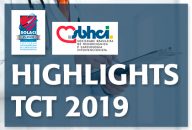Aspirin discontinuation 1 to 3 months after angioplasty with continued P2Y12 inhibitor therapy reduces the bleeding risk without an increase in thrombotic events. This is also the case for patients admitted with acute coronary syndrome. Dual antiplatelet therapy with aspirin and a P2Y12 inhibitor has been shown to reduce the risk of major events compared with…
Is Medical Treatment Better at Lowering Bleeding-Caused Mortality than Angioplasty?
Post-discharge bleeding in patients admitted for acute coronary syndrome (ACS) is linked to higher all-cause mortality. However, this is the case for both patients who underwent angioplasty and those who were managed with medical treatment. These are interesting data, given that medical treatment is frequently preferred due to lower bleeding risk. Speculation is based on…
Bleeding and Cardiogenic Shock: An “Unholy Alliance”?
Courtesy of Dr. Carlos Fava. Mortality in acute myocardial infarction (MI) with cardiogenic shock (CS) has been reduced over the past two decades. This has been possible thanks to early angioplasty, greater operator (and overall medical team) experience, new antiplatelet therapies, and ventricular assist devices, which have also been somewhat relevant in this setting. However, in…
Frailty and Bleeding: Impact on Aortic Valve Replacement
Courtesy of Dr. Carlos Fava. We are well aware that both transcatheter aortic valve replacement (TAVR) and surgical valve replacement (SAVR) generate bleeding (15% to 22% for TAVR and 22% to 44% for SAVR). Frail patients constitute a particular group. These have not yet been assessed as to the real risk they run and mortality…
Virtual ACC 2020 | TWILIGHT-DM: Ticagrelor Monotherapy in Diabetic Patients
In parallel to the TWILIGHT in patients with complex PCI, Dr. Angiolillo virtually presented the sub-study in diabetic patients, and it was published simultaneously in J Am Coll Cardiol. This study focuses on the clinical complexity of patients, rather than the technical complexity of the procedure itself. The TWILIGHT-DM analyzed 2620 diabetic patients from the…
Net Benefit of Left Atrial Appendage Closure vs. Anticoagulation in Atrial Fibrillation
This analysis shows that the long-term clinical benefit of left atrial appendage closure with Watchman is superior to warfarin in patients with atrial fibrillation (AF). The initial peri-procedural risks of device implantation are counterbalanced over time, with reduced risk of bleeding and death. The PROTECT-AF (Watchman Left Atrial Appendage Closure Technology for Embolic Protection in…
Major Bleeding in Patients with Aspirin Plus Rivaroxaban
The combination of coronary artery disease or peripheral vascular disease and a reason for anticoagulation, such as atrial fibrillation, results in many patients who receive antiplatelet therapy with aspirin plus anticoagulation with rivaroxaban, for example. It is a well-known fact that this combination (aspirin 100 mg per day plus rivaroxaban 2.5 mg twice per day) reduces cardiovascular…
Major Bleeding in Patients with Aspirin Plus Rivaroxaban
The combination of coronary artery disease or peripheral vascular disease and a reason for anticoagulation, such as atrial fibrillation, results in many patients who receive antiplatelet therapy with aspirin plus anticoagulation with rivaroxaban, for example. It is a well-known fact that this combination (aspirin 100 mg per day plus rivaroxaban 2.5 mg twice per day) reduces cardiovascular…
TCT 2019 | EVOLVE Short DAPT: Only 3-month DATP in High Risk Bleeding
Courtesy of the SBHCI. This study used the thin strut everolimus eluting stent with ultrathin abluminal bioresorbable polymer coating chromium platinum stent, basically the Synergy stent. Drug release and polymer degradation within four months facilitate endothelization and would allow a shorter DAPT. Presented during the scientific sessions of TCT 2019, this study included 2009 high…
TCT 2019 | Onyx ONE: Durable Polymer vs. Polymer-Free Stent with Only One Month of Dual Antiplatelet Therapy
Courtesy of the SBHCI. This is the first randomized study comparing a durable-polymer drug-eluting stent (zotarolimus-eluting stent Onyx) and a polymer-free drug-eluting stent (biolimus-A9-coated stent BioFreedom), with only one month of dual antiplatelet therapy in patients at high risk for bleeding. Onyx ONE was a study conducted at 84 sites that randomized 1:1 2000 total patients at…







